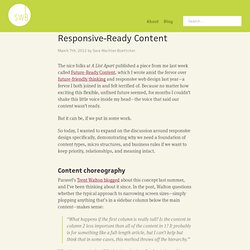

Content strategy. McGrane: Kill Your CMS THE ERA of “desktop publishing” is over.

Same goes for the era where we privilege the desktop web interface above all others. The tools we create to manage our content are vestiges of the desktop publishing revolution, where we tried to enable as much direct manipulation of content as possible. In a world where we have infinite possible outputs for our content, it’s time to move beyond tools that rely on visual styling to convey semantic meaning. If we want true separation of content from form, it has to start in the CMS. Future-Ready Content. The future is flexible, and we’re bending with it.

From responsive web design to futurefriend.ly thinking, we’re moving quickly toward a web that’s more fluid, less fixed, and more easily accessed on a multitude of devices. As we embrace this shift, we need to relinquish control of our content as well, setting it free from the boundaries of a traditional webpage to flow as needed through varied displays and contexts. In the words of futurefriend.ly’s Brad Frost, “get your content ready to go anywhere because it’s going to go everywhere.” Sara Wachter-Boettcher, Content Strategist. The nice folks at A List Apart published a piece from me last week called Future-Ready Content, which I wrote amid the fervor over future-friendly thinking and responsive web design last year—a fervor I both joined in and felt terrified of.

Because no matter how exciting this flexible, unfixed future seemed, for months I couldn’t shake this little voice inside my head—the voice that said our content wasn’t ready. But it can be, if we put in some work. So today, I wanted to expand on the discussion around responsive design specifically, demonstrating why we need a foundation of content types, micro structures, and business rules if we want to keep priority, relationships, and meaning intact. Content choreography Paravel’s Trent Walton blogged about this concept last summer, and I’ve been thinking about it since. “What happens if the first column is really tall? What happens, indeed? If you haven’t seen it yet, the homepage works pretty well. Or so: Mobile first? Structure first. More mobile devices equals more news consumption, says study. New research shows that smartphone and tablet-toting Americans are packing their day with more news than ever before, allaying publisher fears that people might quit the news for other digital distractions.

The findings, conducted by the Pew Research Center and the Economist Group, were presented Monday at an advertising week event in New York. They showed that news was the second most popular activity after email on smartphones and tablets, and that people who used both types of devices were likely to consume more overall news than before. In practice, this means that publishers are adapting to what Denise Warren of the New York Times calls the “multi-platform news user.” Warren says this user is likely to read the Times on a tablet in the morning and in the evenings, and to use their phone as an “interstitial” news device during the day. While the Pew findings are encouraging for news consumption, the revenue findings are less rosy. Scan and Analysis of Best Practices in Digital Journalism In and Outside U.S. Public Broadcasting.
Principal Investigator: Pat Aufderheide Investigators: Jessica Clark, Matthew C.

Nisbet, Carin Dessauer Research Associate: Katie Donnelly To read this document as a PDF, click here. Table of Contents In this report, researchers at American University’s Center for Social Media identify a set of best practices in digital new media journalism intended to guide planning and initiatives in this area specifically for the Corporation for Public Broadcasting (CPB) and more broadly for the Public Service Media community in the US. Methodology: We developed an initial list of best practices in digital journalism after a considered examination of recent relevant reports, publications and conference proceedings, and then conducted hour-long interviews with ten experts—thought leaders, innovators, practitioners and researchers—who are examining a broad range of digital journalism projects and outlets. Best practice categories identified: Blog_standards.pdf (application/pdf Object) Open Platform launch partners. Today we announced the launch of the Guardian Open Platform.
The Open Platform is the suite of services that enables partners to build applications with the Guardian. We're lucky enough to have a few launch partners who have already built applications with our new services. In addition to our client library authors Kalv Sandhu, James Darling, Tom Armitage, Dave Nattris and Michael Lee, the following partners have already begun working with us: AMEE has partnered with us in our Data Store.
We're looking at how we might be able to use the Open Platform to help data providers like AMEE release their data more widely. AMEE's aim is to map, measure and track all the energy data on Earth. Stamen Design Stamen created a fantastic crowdsourced news geotagger using OpenStreetMap. The software is called APIMaps which we are releasing together as an open source project. Stamen Design is a development firm based in San Francisco.